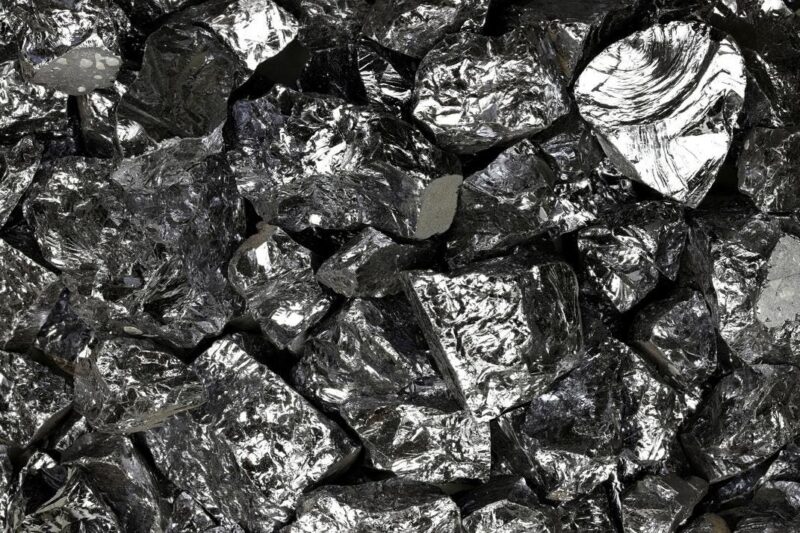High-purity polycrystalline silicon.
getty
To strengthen the national security supply chain, the U.S. government has revamped a proposed critical mineral list with six new additions that have implications for key industries.
The U.S. Department of the Interior’s Geological Survey has increased its proposed list of 2025 Critical Minerals to 54. The new list, if finalized, would remove two from 50 on 2022 and add six new substances.
The proposed additions are: copper, lead, potash, rhenium, silicon and silver.
- Copper—is mostly used in building construction, electronics, transportation, industrial machinery and consumer goods.
- Lead—is used by lead-acid battery industry for vehicle starting-lighting-ignition batteries and standby power for computers and telecommunications networks.
- Potash—is primary used by the fertilizer industry and also in chemical and industrial applications.
- Rhenium—mostly is a superalloy in parts for high-temperature turbine engines and petroleum-reforming catalysts.
- Silicon— a primary component in semiconductor material.
- Silver—has multiple uses in investment bars, coins, jewelry, electronics, photovoltaics, photography and brazing and soldering.
To create the new list, USGS relied on a supply-chain disruption computer analysis of the likely impacts of what would happen if 84 minerals were disrupted in 1,200 trade scenarios. Factored into the forecasting was the effects of disrupted critical minerals on 402 industries as well as the potential impacts to the U.S. economy.
The USGS noted how the forecasting system worked in ugust when it released the draft critical mineral list. “The modeled economic impacts were then weighted by the probability of the disruption scenario. Probability weighting combines the likelihood of a scenario occurring with the impact of the scenario. For example, one scenario represents the complete restriction of U.S. net imports of rhodium from South Africa. The impact of that scenario on U.S. GDP was estimated to be a decrease of $64 billion, but its probability of occurrence was only 3.9%, yielding a probability-weighted impact of nearly $2.5 billion,” USGS said.
The agency then create a list of the top 10 most vulnerable minerals in the U.S. supply chain. The following critical minerals were listed in the order of importance: samarium, rhodium, lutetium, terbium, dysprosium, gallium, germanium, gadolinium, tungsten and niobium.
The USGS says its new forecasting model provides economic predictions on critical mineral scenarios that can be linked to national goals. Another benefit is using the information to create risk mitigation plans.
Metallurgical Coal and Uranium
The USGS is has also sought input about adding to its list both metallurgical coal (used in steel production) as well as uranium since the vast majority is imported for commercial nuclear energy plants.
Currently the federal government taking multiple steps to revive both the coal and nuclear power industry through a series of actions taken by the U.S. Department of Energy and the Nuclear Regulatory Commission.
Removal of Tellurium and Arsenic
USGS geologists and staff from New Mexico Bureau of Geology and Mineral Resources examine rocks for tellurium in New Mexico.
Karen Duttweiler Kelley/U.S. Geological Survey
The 2025 draft list of critical minerals removed tellurium and arsenic from the 2022 list.
Tellurium is a rare element that is generally a byproduct of processing copper. Its uses include thin-film solar cells, thermoelectric devices, processing rubber and as a steel additive.
Arsenic can be used a strengthening metal alloy. It is also important in herbicides, insecticides, wood preservatives and semiconductors for solar cells.
Both minerals were evaluated for inclusion in the 2025 list as well as cadmium, feldspar, gold, helium, iron ore, mica, molybdenum, phosphates, selenium and strontium.
Though the USGS says many minerals, such as the ones above, are important to the U.S. economy, some didn’t make the 2025 list since the substances can be met “largely through domestic mining and processing and thus a supply disruption is considered unlikely.”
Public Input May Change Final List
At present, the USGS is sifting through 163 public comments to its draft 2025 List of Critical Minerals. The agency also wants to determine if it should release a critical minerals list annually instead of every three years.
The 2022 list contained 50 critical minerals. The USGS concedes in its Federal Register notice issued on Aug. 26 is critical mineral needs can shift in national importance over time.
Therefore, the USGS says some minerals on the draft 2025 list may be dropped or added.









